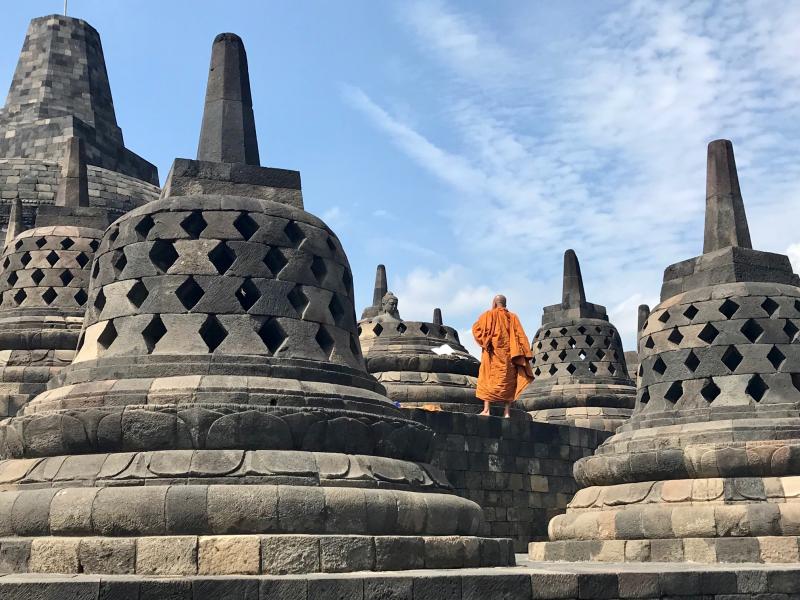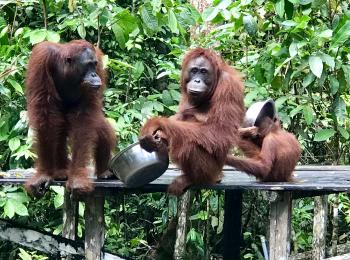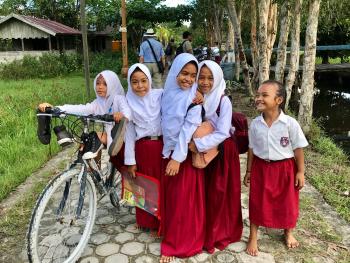Island hopping – from Hong Kong to Indonesian Borneo and Java
This article appears on page 38 of the April 2019 issue.
After a trip to wild Papua New Guinea years ago, I was enticed by the knowledge that the western half of the island of New Guinea is part of Indonesia. (PNG, on the eastern half, is an independent nation.) The opportunity to visit Indonesia presented itself when two friends I'd met on my Five 'Stans adventure invited me to join them there. After checking the exciting pre- and post-trip itineraries, I was in!
Hong Kong
Since I would be so close to Hong Kong and had never been, I decided to stop over for four days before meeting the group from Overseas Adventure Travel, or OAT (Boston, MA; 800/955-1925, oattravel.com), in Jakarta, Indonesia. I would have to face my fears of maneuvering the crowded streets and bustling underground metro on my own and not get irretrievably lost every time I exited the hotel.
Through Viator.com, an absolutely user-friendly online travel site, I booked adventures daily. The hotel staff at The Charterhouse Causeway Bay Hotel (209-219 Wanchai Rd.; hongkonghotel.charterhouse.com) always watched for me as I began my day, with their red-marked maps for me in hand. They even gave me a Hong Kong-compatible cell phone in case of emergencies.
Walking tours are a great way of exploring a different culture. On my first day in Hong Kong, I went on an Eating Adventures (eatingadventures.com) tour in the Mong kok neighborhood (HKD690, or $88). I was the only one who showed up for this walking food tour, so loquacious Yan was my private guide for the evening. Through this up-close and personal tour, I was able to experience one of the neighborhoods in Hong Kong through the eyes of a local.
Worried that I was going to get lost at night, Yan insisted on accompanying me in the hot, steamy, crowded metro at the end of the tour, and then she walked with me all the way to my hotel lobby.
I got lost only three times on the way to my Day 2's tour of Lantau Island, which included visits to the giant Shakyamuni Buddha, the bustling port and the houseboats with people quietly repairing nets. Unfortunately, I was staying in the Wan Chai area, which is on the northern side of Hong Kong Island, and all the tours started on Kowloon, on the other side of the harbor on the mainland. Who knew?!
I also took an "off-the-eaten-path" walking food tour (HKD688) in the Whampoa neighborhood of Kowloon, created by the perky, full-of-local-knowledge Virginia, owner of Humid with a Chance of Fishballs (humidwithachanceoffishballs.com). I got truly lost on my way to the tour, and the fun group had to find me to begin. (Very few people spoke English when I sought help on the street, even though I was told ahead of time that, with Hong Kong having been governed by Britain for so long, English would be endemic. It isn't.)
We ate and drank our way through the area, entertained by Virginia's stories and her relationships with the shopkeepers on the street.
Virginia hailed 10 taxis before she finally talked one into taking me back to Wan Chai, as many taxi drivers in Kowloon don't want to cross the harbor at night and pay the tunnel toll both ways. (Also, they likely won't find a return fare to take back to Kowloon.)
On my last day in Hong Kong, I explored Hong Kong Island through the eyes of a tourist, with visits to the Stanley Market and the Aberdeen waterfront. I took the tram up to Victoria Peak and enjoyed unparalleled views of the immense harbor.
Borneo
Hankering for some company, I boarded a plane for Pangkalan Bun, on the Indonesian part of the island of Borneo. There, a small group of nine, myself included, boarded a klotok (a traditional style of riverboat) for the next few days as we cruised the Sekonyer River until we entered Tanjung Puting National Park. This park protects a 140-million-year-old tropical forest that is home to an outstanding diversity of plant and animal life, including orangutans.
After a long, hot and steamy walk through the park, we began to get up close and personal with these magnificent beasts. I was so excited!
Because the forests are (illegally) being cut down at a rapid pace to make room for planting palm trees, from which oil can be extracted, the habitat and food sources for the orangutans are shrinking. To protect the animals, the national park provides feeding stations, offering milk and bananas and other fruit every couple of days. There is also extensive repatriation of captured or orphaned orangutans in this park.
Borneo is trying to work with Malaysia and Japan to end the killing of orangutan mothers for their babies, and they are trying to reduce the palm-tree plantation encroachment.
After waking up the next day to birdsong and the whoop-whoop of the gibbon's call, we ventured to another feeding station through the jungle. On our many hikes into the interior of the park to find the orangutans, I was fascinated, as their amazingly long arms enabled them to swing from tree to tree, and the flexibility of their limbs enabled them to spread their legs to hang between two widely spaced trees.
As the animals would drop down from the trees for the feedings, they were constantly vigilant in looking out for the "big daddy" or other aggressors who might appear. They were always nervously looking over their shoulders, listening for the rustling in the bushes and trees, and scurried away with babies attached to their breasts when a more dominant orangutan might be approaching.
Their antics on the feeding platforms were mesmerizing. I was enchanted.
At times, a youngster would run by me, knocking against me. They were on their own, unpredictable and capricious. When they stood, leaning on a tree, they were taller than me.
I was also charmed by the walk through Sungai Sekonyer village, where we learned crafts, interacted with locals, bought fresh fish for our dinner and learned about the villagers' way of life — my kind of travel.
Java
Our next stop was Jakarta, Indonesia's capital and largest city. After Indonesia gained independence from Dutch rule in 1945, Jakarta, once the colonial capital, emerged with its diverse cultural heritage intact.
Indonesia's population is 87% Muslim, and the full force of Ramadan was heralded with loud calls to prayer seven times a day (this sacred time requiring extra prayer calls). With the loudspeakers blaring, we took 3-wheeled scooters to Fatahillah Square, where I fell in love with the puppet museum and my puppet souvenir, purchased from a puppet master there.
A trip to Istiqlal Mosque, the largest mosque in Southeast Asia, allowed us to quietly observe the preparation rituals and prayers of the 200,000 Muslims who filled the structure.
In Chinatown, our visit was intensified with a sit-down talk with the leader of the Chinese community there, who quietly related stories of the May '98 riot in Jakarta, where many of the minority Chinese were attacked and killed.
We then flew to Yogyakarta (aka "Jogja"), the epicenter of Javanese arts. OAT creates many personal contacts with locals, and here we had a home visit with a family.
Three of us visited a Christian family, who shared with us what they normally eat and do in their daily lives. It was amazing that there was a mosque with calls to prayer blaring day and night right next door to their home, demonstrating that, in this community, different cultures and religions are able to live in harmony.
It was an immensely personal experience in a culture so remote from my own. This is what drives my travels.
Memorable moments
At Sekar Rinonce, a foundation dedicated to conserving batik, we were handed wax, ink and cloth for a lesson in this disappearing art. It was an authentic connection to the arts of Indonesia.
Our journey to Borobudur, a UNESCO World Heritage Site, was mind-boggling. One of the greatest Buddhist monuments in the world, it is a massive stepped temple with a 150,000-square-foot base and hundreds of intricate carvings dotting the six square tiers to the top.
As I quietly observed an orange-clad monk praying at the top level amidst 72 small, latticework stupas (each one with a Buddha statue inside), I was reminded of the magnitude of this sacred place.
Only three of us volunteered to go on what I found to be the most eye-opening walk of the trip. Our guide, Em, wanted us to see the community situated underneath the bridge over the Gondokusuman River in Jogja. A wonderful man had donated money to clean up this former slum so the people could live with cleaner water and more sanitary conditions.
The three of us stayed and talked to the group in their communal living area while they were all atwitter observing us. It was a defining moment for me to see how this group has created a functioning community with so little.
As we were leaving, we heard some toe-tapping music, and the next thing I knew, I was beckoned to join the dance. Captivated by the moment, I jumped in.
Another truly moving couple of hours transpired when Em arranged for a woman who had been in prison in 1965 (when she was 10!), accused of being a Communist, to share her personal narrative with our group. Following a failed coup, there was a purge in Indonesia of anyone even remotely suspected of being a member of the Communist party, and thousands of innocent people disappeared, were murdered or were horribly abused for years. Even today, the lives of the people who were suspected are still affected. It is a period in Indonesian history that is usually never discussed in public.
Our group then flew to Bali, with its rainforest-covered volcanic peaks and white-sand beaches, to start the next part of our adventure.
Next month, the journey continues.



